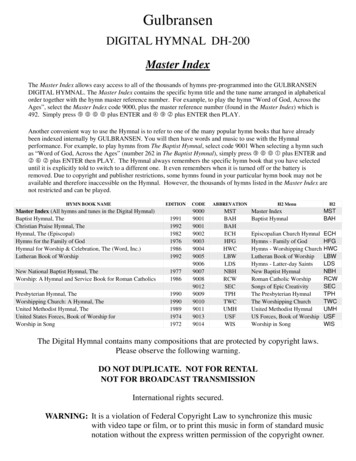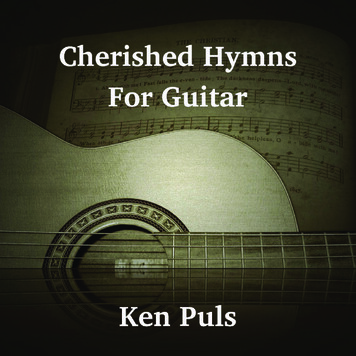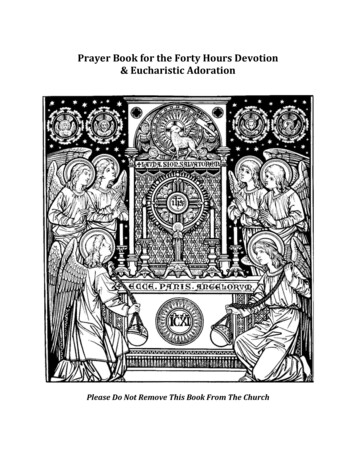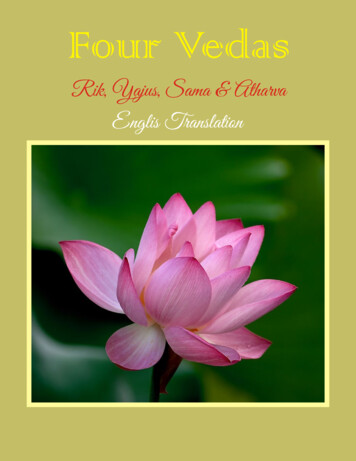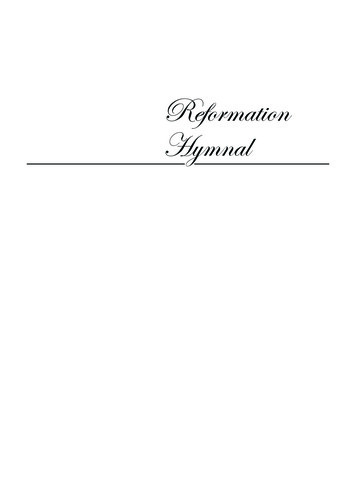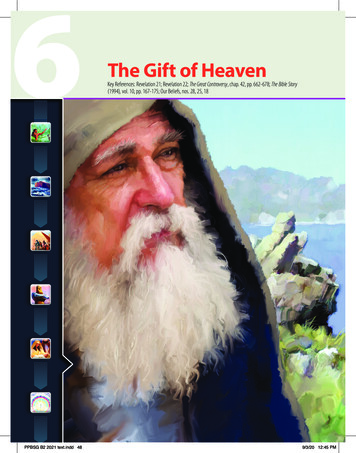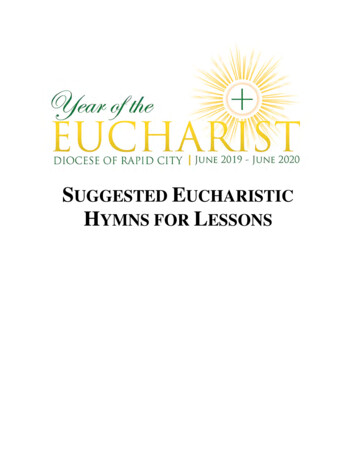
Transcription
SUGGESTED EUCHARISTICHYMNS FOR LESSONS
ContentsYear of the Eucharist Hymns 3General Hymn Lesson Format, Confirmed Youth and Adults 4General Hymn Lesson Format, Age of Reason, Pre-Confirmation 5Sample Lesson for First Communion to Pre-Confirmation 6General Hymn Lesson Formation, Pre-Age of Reason 7Sample Lesson for Pre-Age of Reason 8Suggested Hymn for September 2019: Lord, Who at Thy First Eucharist 10Suggested Hymn for October 2019: Amen, El Cuerpo de Christo 12Suggested Hymn for November 2019: I Am the Bread of Life 13Suggested Hymn for December 2019: Ubi Caritas (Hurd) 14Suggested Hymn for January 2020: Bread of Life (Fisher) 15Suggested Hymn for February 2020: O Sacrament Most Holy 17Suggested Hymn for March 2020: Tantum Ergo 18Suggested Hymn for March 2020: O Saving Victim 21Suggested Hymn for April 2020: Ven al Banquete/Come to the Feast 23Suggested Hymn for May 2020: Taste and See (Moore) 26Optional Eucharistic Hymn: I Received the Living God 27Optional Eucharistic Hymn: As We Gather at Your Table 28Optional Eucharistic Hymn: Our God Is Here 30Optional Eucharistic Hymn: Unless a Grain of Wheat (Hurd) 32Page2APPENDIX A ADDITIONAL LESSON PLANNING MATERIAL FORLORD, WHO AT THY FIRST EUCHARIST 33
Year of the Eucharist HymnsGOAL:To bring people to an encounter with Jesus in the Eucharist through: Formation experience The Celebration of the Mass The Real Presence of Jesus in the Sacred SpeciesPATRONESS: The Virgin Mary of the Annunciation is our model for the Year of the Eucharist. Mary encountered Jesus within herself through the power of the Holy Spirit. Mary questioned how this was possible and received understanding. Mary opened herself to the real presence of the Lord and encountered Jesus. May we all encounter the Lord through our participation in Mass, including oursinging of the hymns.EUCHARISTIC HYMNS Teach hymns with solid eucharistic texts as part of formation activities. Encourage parish liturgists and musicians to include songs with solideucharistic texts in the celebration of the Mass. Introduce with proper catechesis the best Latin hymns from the Catholictradition with instruction on how and why to pray the Latin texts.SELECTING THE HYMNS FOR YOUR PARISH LESSONS A particular Eucharistic hymn is suggested for each month, September 2019through May 2020. There are six additional hymn lessons included in this resource. Parishes may use the suggested hymn for the month or another hymn from theadditional list. Make sure that the catechists and musicians know which hymn your parish willstudy each month.PageComposer M. D. Ridge, Musical Musings, St. Louis University Sunday Web SiteOctober 29, 20163REFLECTION ON SCRIPTURALLY-BASED HYMNS:It’s a double reinforcement: singing the song helps implant the scriptural textin our hearts and minds and bodies in a way that reading or hearing can’t. Atthe same time, reading or hearing the text calls up the song in our minds againand again.
General Hymn Lesson Format, Confirmed Youth and AdultsEVENT:Teaching of a Eucharist HymnAGE:Post Confirmation to AdultGOAL:The hymn becomes a prayer in which all truly encounter Christ in theMass.REVIEW: Previous learned songs Year of Eucharist teachings How participants are encountering the Lord through songPREPARATION: Know the hymn Have the materials and resources at hand Invite parish musicians or other confident singers to ESSONFORMAT:Provided in each lesson Lesson Plan Means of Playing Hymno piano, guitaro computer/screen/TV/internet access Hymnal Musicians & SingersSing the hymn at liturgy during the month of the teaching. Work withparish musicians to include this hymn in their planning. Opening Prayer Review hymn from prior month Introduce hymn for current month (background, themes,scripture) Sing hymn together Reflection questions Optional small group discussion Sing hymn together as closing prayerPageMany hymns are composed to fit a well-known melody according to a metrical pattern. Hymn tunes are classifiedby the number of syllables in each line, or meter. Generally, any set of lyrics may be sung to any hymn tune withthe same number of syllables per line. They are identified by those numbers. For example, the hymn tune Hyferdol(87 87 Double) is used for many songs, such as Alleluia! Sing to Jesus and Love Divine, All Loves Excelling.However, since the hymn tune Beach Spring has the same meter, the lyrics for songs with that tune (Healing Riverof the Spirit, Lord Whose Love in Humble Service) may also be sung to Hyferdol, and vice versa. Many hymnalshave a metrical index that tells which tunes are found on which page. So if you don’t know the tune of a song,count the syllables and look up a hymn tune that you know in the index – switch to that tune and you’re all set!4Note about hymn tunes:
General Hymn Lesson Format, Age of Reason, Pre-ConfirmationEVENT:Teaching of a Eucharist HymnAGE:Age of Reason, post-First Communion, pre-Confirmation(Elementary grades 2-5)GOAL:Fuller participation in the celebration of the Eucharist through hymns.REVIEW: Previous learned songs, words, meanings, pronunciations fromprior classPREPARATION:VOCABULARY:MATERIALS/RESOURCES: Know the hymn Have the materials and resources at hand Invite parish musicians or other confident singers to assistProvided in each lesson, where appropriate Lesson PlanMeans of Playing Hymno piano, guitaro computer/screen/TV/internet accessHymnalMusician, singerAPPLICATION: Opening PrayerReview hymn from prior monthListen to the hymn for this monthDiscuss through questions and responses what the hymn isabout and why we would sing it at MassTell the Bible stories referred to in the hymnIf the hymn is new, teach the refrain first, then the verses.Sing hymn togetherHave an activity that relates to the hymn – a page to color,drawing time, a moment of adoration, just a quiet moment inthe chapel, a procession with an image of Christ that relates tothe EucharistOptional snack timeSing hymn together as closing prayer5 PageLESSONFORMAT:
Sample Lesson for First Communion to Pre-ConfirmationAs We Gather at Your TableBACKGROUND INFORMATION“As We Gather at Your Table” was written by Carl P. Daw, an Episcopal priest in 1989 for achurch celebration.PRIMARY THEMEThe song tells us to bring everyone you meet to God. God loves everyone. Receiving theEucharist strengthens us to teach other people about God.SECONDARY THEMEWe should forgive others as God forgives us.SING THE HYMN TOGETHER OR PLAY A RECORDINGDISCUSSION QUESTIONSVerse 1: Read “The Parable of the Banquet” Luke 14:1-24 or tell it in your own words. How does this parable tell us that God wants everyone to feel welcome in His Church? In the first verse, what parts of the Mass are referenced? How does this verse make you think about Holy Communion?Verse 2:Pray the “Our Father” together. What words in the song refer to this prayer? How are we being asked to forgive other people?Verse 3: What are we asking of the Holy Spirit in verse three? What do you think the words “envy” and “pride” mean in the song? What does it mean to invite everyone to the feast? How in your life can you “.repeat the sounding joy”?ACTIVITYInvite the students to draw a picture of “The Parable of the Banquet,” of ways to make peoplefeel welcome at Church, or of someone showing forgiveness. Share a snack making a point ofwelcoming everyone to the table and sharing out the snack.PageLesson Notes: This is a very large age group. Adapt the questions and activities to your group.Some of the discussion questions are not appropriate for young elementary students. Youngerstudents might benefit more from hearing simplified version of “The Parable of the Banquet” andtalking about forgiveness based on the words of the “Our Father.” Or, instead of discussionquestions, have students draw a picture about the parable and share with the class about whatthey drew. In a class with younger students, you may only want to talk about the 1st verse.6SING THE SONG TOGETHER OR PLAY A RECORDING AS A CLOSING PRAYER
General Hymn Lesson Formation, Pre-Age of ReasonEVENTTeaching of a Eucharist HymnAGEThree through Pre-First CommunionGOALTo be able to participate in Mass by singing the hymn andunderstanding more about the EucharistREVIEW PREPARATION VOCABULARYMATERIALS/RESOURCESSomething specific about Mass that they’ve learned in previousclassesPrevious learned songsHow God is presentWhy we sing hymnsKnow the hymnPrepare dialogueHave the materials and resources at handInvite parish musicians or other confident singers to assist(Suggested) Plan an activity to engage them more fully – drawpictures, act out Bible stories, play a game that lets them moveand make noise, practice silence/reverence, make handmovements that show our feelings about the song as we listen toa recording, sway or march in time while singing the song, (Optional) Arrange for a snackProvided in each lesson, where appropriate Lesson PlanMeans of Playing Hymno piano, guitaro computer/screen/TV/internet accessMusicians & SingersChalk board or white board (optional)Art supplies (optional)Snacks (optional) Opening PrayerReviewTalk about the new hymnListen to the hymnPageLESSONFORMAT7APPLICATION
Dialogue about what it means, how it helps us know Jesusbetter, put the theme in words they can understandTell Bible stories referred to in the hymnTeach the hymn, refrain first, one lines at a time. It may be toomuch for them to learn all of the hymn at this age. Pay attentionto their attention span and limit the lesson to match.If the rhythms are tricky, clap them, one phrase at a timeOptional activitySing hymn together as closing prayerOptional snack timeSample Lesson for Pre-Age of ReasonAs We Gather at Your TableToday we are going to learn a song that tells us how much God wants to be with all of us andthat he loves us very much. Listen while I sing of the song or listen to the recording.This song can be sung in English or Spanish. Use the primary language of the children.Depending on the children, you may only choose to only sing and discuss the 1st verse.1st VerseThe song talks about gathering at God's table and listening to the stories He tells us.Did you know that the table at Mass is the altar? When you eat at home or at school youprobably have a table. God wants there to be a place for everyone at His table. Do you always sitat the same place at your families table when you eat dinner? (Let students respond.) If youhave company for dinner does your Mom or Dad figure out a way to make room for everyone atthe table? (Let the students respond.)The food we eat at the dinner table at home helps feed our bodies. God feeds us too. He feed uswith the Eucharist. Sometimes people say Holy Communion instead of the Eucharist. Thesacred stories we hear at Mass feed our hearts and minds. The stories we hear from our familiesalso help us learn.PageDepending on the age and interest of the students, you may only discuss the first verse beforemoving on to the art activity and snack.8The song calls Mass a “holy banquet.” What is a banquet? (Allow students to respond. Accepttheir answers and work to adjust them.)
2nd VerseDid you know that God will always forgive any mistakes you make if you are really sorry andtell him you are sorry? Isn't that kind and loving of Him? He also wants us to forgive otherpeople when they are mean to us.Did you know that God's son, Jesus died for us? God loves us that much. (Listen to what thestudents have to say about forgiveness and Jesus dying for us.)3rd VerseGod wants everyone to feel welcome at Church. How can we make people feel welcome whenthey come to Church? (Listen to their ideas. If necessary add some of your own tips on ChurchHospitality.) How can we tell people that don't know about God that He loves them? Who canwe invite to come to Church? (Listen to their ideas.)ACTIVITIES:Have the children draw a picture of the altar, their family around the dinner table, or some part ofthe song that especially interests them. Or, have the students color a coloring page you feel isappropriate.Have a snack around a table and make a point of welcoming everyone to the table and sharingthe food.Sing “As We Gather at Your Table” or play a recording of the song.NOTES AND REFLECTIONSPage9
Suggested Hymn for September 2019: Lord, Who at Thy First Eucharist* Additional lesson planning material can be found at Appendix ABACKGROUNDWritten in 1881 by author WilliamH. Turton for an anniversaryservice held at London’s St. MaryMagdalene’s Anglican Church. Setto the tune “Unde Et Memores” byorganist and composer William H.Monk, written in 1875. In theLiturgy of the Hours, it is an optionfor the Hymn of Morning Prayer ofthe Most Holy Body and Blood ofChrist (Corpus Christi).PRIMARY THEMEA disciple’s response to the “highpriestly prayer” of Jesus for unitywithin the Body of Christ by theeucharistic celebration of theSacrament of His Body (i.e., thethree-fold refrain of “through thisblest sacrament of unity”).PageOTHER THEME(S) Themes also include a book-ended reference to the first and the last (the beginning andthe end) instances of the eucharistic celebration; the image of the Lord as Prince of Peace and the Good Shepherd; the gifts of peace and love ultimately producing the fruit of unity; the work of Christ and the Holy Spirit; expressive of hope, with references to faith and love. Ultimately, the last verse gives good context for the greatest hope: unity with the Trinity.This unity is ultimately the work of God in the Church: Christ and the Holy Spirit, whobring us into union with the Father.10SCRIPTURAL REFERENCES John 17; see especiallyverses 11, 21, 22, 23 Alpha and Omega (Rev;see verses 1:8; 1:17; 2:8;21:6; 22:13; Is 41:4; 44:6); Prince of Peace (Is 9:5);Good Shepherd (John 10:1-18, esp. verses 11 and 14); Fruits of the Holy Spirit (Gal 5:22); Theological virtues of Faith, Hope, Love (1 Cor 13:13)
LITURGICAL NOTESTwo solemn liturgical celebrations within the life of the Church point to these realities: thesolemnities of the Most Holy Trinity (first Sunday after Pentecost) and the Most Holy Body andBlood of Christ (second Sunday after Pentecost), both of which are celebrated on consecutiveSundays.REFLECTION How does Christ’s prayer for unity affect my celebration of the Eucharist? Do I pray for unity in the Church? How can I help to heal division in the Church? In my family? In my community? In theworld? Who do I know who has “wandered from the fold?” How can I help Jesus in leadingthem back? During the Mass, when are we specifically praying for other people? Do I fullyparticipate in those prayers through my attentive silence and my response (asappropriate)?VOCABULARY Theological Virtues (Faith, Hope, Love) Fruits of the Holy Spirit (charity, joy, peace, patience, kindness, goodness, generosity,gentleness, faithfulness, modesty, self-control, chastity)NOTES AND REFLECTIONSPage11
Suggested Hymn for October 2019: Amen, El Cuerpo de ChristoAMÉN, EL CUERPO DE CRISTOBACKGROUND TO HYMNComposed by Fr. John Schiavon, a priestfor the Archdiocese of Los Angeles. Hisbilingual English-Spanish pieces are oftenused at diocesan celebrations across thecountry, especially this one, which wasused in the Mass celebrated by PopeBenedict XVI at Yankee Stadium in 2008.It’s frequently used on Corpus ChristiSunday.PRIMARY THEMEThis song celebrates the Body of Christ(Cuerpo de Christo), meditating on the realpresence of the Body and Blood of JesusChrist, the Son of God, in the elements ofthe Holy Eucharist.SECONDARY THEOLOGICALPOINTS We become what we receive. Weare transformed into Jesus Christ –one with him and with all who areone in his body, the Church. In the sacrifice of the Mass, weremember and participate in Christ’s eternal sacrifice. We are one in Christ. We recognize our call to serve others. We eagerly await Christ’s return in glory.PageQUESTIONS FOR REFLECTION1. What phrases in the text stand out for me?2. What does that phrase mean to me in my celebration of the Eucharist?3. How can the text of this song help me to encounter Christ?4. How does this hymn inspire me to pray?5. Do I listen to the words when I sing this hymn?12SCRIPTURE REFERENCES 1 Corinthians 12:27: “Now you are Christ’s body, and individually parts of it.” 1 Corinthians 10:17: “Because the loaf of bread is one, we, though many, are one body,for we all partake of the one loaf.” Proverbs 22:9: “The generous will be blessed, for they share their food with the poor.” Mark 13:26: “They will see ‘the Son of Man coming in the clouds’ with great power andglory.”
Suggested Hymn for November 2019: I Am the Bread of LifeBACKGROUNDSister Suzanne Toolan, RSM, creatorof the communion song, “I Am theBread of Life,” is an internationallyknown composer of liturgical music.She wrote “I Am the Bread of Life”for a music educators’ conference in1966. She is a prominent Americanspokeswoman for the music andprayer of the Taizé ecumenicalcommunity from France and leadsmany Taizé-style retreats.Published by GIA Music.PRIMARY THEMEPaschal Mystery: Jesus is the Breadof Life, come down from heaven. Hissacrifice on the cross gives us life. Hedesires that we receive life in theEucharist – His Body sacrificed andHis Blood poured out for us.SECONDARY THEOLOGICALPOINTSEternal life, Faith, ResurrectionSCRIPTURE REFERENCESJohn 6:35, 44, 41, 53-54 Bread of LifeJohn 11:25-27Samaritan woman at the wellPage13QUESTIONS FOR REFLECTION What does it mean to me when Jesus tells us that he is the Bread of Life? Do I come to Jesus to fill the hunger in my life? How does believing in Jesus satisfy my spiritual thirst? How do I hear and acknowledge the Father beckoning me to come to Him? Do I believe that Jesus in the Eucharist is the Christ, the Son of God, who has come tous? Do I believe that the Eucharist is truly the Risen Lord? How does that affect the way Iapproach and receive the Body and Blood of Christ?
Suggested Hymn for December 2019: Ubi Caritas (Hurd)BACKGROUNDUbi Caritas is taken from theantiphon sung during the ceremonyof the washing of the feet at theMass of the Last Supper on HolyThursday. As is the entire Mass ofthe Last Supper, this hymn isintimately connected to and with theEucharist and is thus often usedduring the Exposition of the BlessedSacrament. Recent tradition has thefirst line as "Ubi Caritas et amor"(where charity and love are), butcertain very early manuscripts show"Ubi caritas est vera" (wherecharity is true). The current missalfavors this later version while the1962 Roman missal and classicalmusic favors the former.Composer Bob Hurd has been usinghis knowledge about music andliturgy for 45 years. Starting shortly after Vatican II,when the need arose for new music that the whole assembly could sing, Bob has composed manywell-loved hymns. He is known for being an early pioneer of bilingual and multilingual music.His arrangement of Ubi Caritas was written in 1996 with Spanish text by Pedro Rubalcava.Refrain and vss 1,2,5 based on Ubi Caritas, 9th cent; verses 3,4 text by Bob Hurd. Refrain inEnglish “Where there is true charity, God is present.” Refrain in Spanish “Donde hay caridadverdadera, alli esta Dios”.TRANSLATIONS:Ubi caritas est veraDeus ibi estWhere love is trueGod is therePRIMARY THEME: In loving God we love others. Trly loving others leads us to a deeperlove of God.SECONDARY THEME: Unity, Christian LivingPageQUESTIONS FOR REFLECTION What phrases in the text stand out for me? What verses stand out for me? Do I feel joined together with all gathered at table? Do the words tell of the joy I feel in the presence of the Lord? Do I rejoice when I consider the phrase, “to see you face-to-face”?14SCRIPTURE REFERENCES: I John 4:8
Suggested Hymn for January 2020: Bread of Life (Fisher)BACKGROUNDBread of Life was written by Bobby Fisher in 1994.Bobby is a renowned guitar virtuoso,composer, author and clinician. Hehas toured the world as a workshopclinician, worship leader andperformer. He studied classical guitarand music theory at the Conservatoryof Music of the University ofCincinnati. Since 1988, Bobby hasserved as program director for theNational Association of PastoralMusicians guitar schools. He hasbeen a major presence at conferences,including L.A. Congress, NationalCatholic Youth Ministry conferenceand Music Ministry Alive. He iscurrently director of music ministriesat St. Agnes Catholic Church in FortWright, Kentucky. He makes anurgent call to evangelization with hismusic, encouraging all to "sing fromyour heart, sing to all of creation." He is committed to using his music for peace, unity,understanding, equality and economic justice for all people.PRIMARY THEMEReceiving Jesus in his Body and Blood (Bread of Life) transforms us.The power of the Eucharistic miracle of Transubstantiation in a personal way.Christ is a gift to us, and we are gift to him in our love for one another; in a profound exchange.PageSCRIPTURAL REFERENCES John 6The Bread of Life Discourse Ephesians 4Unity in the Body Romans 12:3Many Parts in One Body 1 Corinthians 13The Way of Love15SECONDARY THEOLOGICAL POINTSThe lyrics in the first verse of the hymn refer to the parallel between his body(bread) and hisblood (the cup) and the pouring out to all of us in a transforming way in our personal lives.Continuing on with the hymn, we see that by this outpouring, we are transformed, our hearts arechanged, our lives are new, our eyes are opened. By this, we are united as one in him. This is aunity that cannot be experienced in any other way. It inspires us and gives us the strength of hisspirit to live in harmony, fostering our friendships, forgiving one another's faults, and giving uscourage for our personal journey with one another. It is thinking each and every time we receivehim, we are being transformed by him into the people he calls us to be. We may fail, but westand confident in his strength being filled with him.
QUESTIONS FOR REFLECTION1. What lines in the hymn stand out for me in my state of life?2. What is the call that I experience in praying the words of this hymn?3. When I read the lyrics, how does this hymn help me to encounter Christ in my everyday life?4. How do these lyrics transform my heart in my relationships?5. How does praying this hymn help me to be gift to Christ? To others?NOTES AND REFLECTIONSPage16
Suggested Hymn for February 2020: O Sacrament Most HolyBACKGROUND TO HYMNO Sacrament Most Holy was a Eucharistic hymn of the 15th Century. This piece is attributed to acouple of authors, John Maubern, writing in 1494, and Irvin Udulutsch, 1958. Although thecommon hymn tune is Fulda, it has been seen in various hymnals with other tunes. The mostcommon tune in our diocese is the Fulda tune.PRIMARY THEMEAdoration of Jesus in the Blessed Sacrament.SECONDARY THEOLOGICAL POINTSThere are 5 verses to the hymn with the refrain sung after each verse. The first 2 verses arereferring to our Eucharistic King whereas the last 2 verses are petitions to the Lord withsupplications such as Saviorand our King, our humblehomage bring; come live inus we pray ourthoughts and actions beyours alone today.The last verse is acalling to eachother to come andeat this bread fromheaven for peaceand strength.QUESTIONS FORREFLECTIONPageVOCABULARYGodhead - The divinity or substance of God.Sacrament - A sensible sign, instituted by Jesus Christ, by which invisible grace and inwardsanctification are communicated to the soul.Homage – great respect and honor171. What lines in the hymnstand out to me?2. When I pray this hymn,how do I encounter Christ?3. How do these lyrics openmy heart to a relationshipwith Jesus? With others?4. How does praying thishymn help me to be conscious of the gift of the Eucharist?
Suggested Hymn for March 2020: Tantum ErgoBACKGROUND TO HYMNThe famous eucharistic hymn, Tantum Ergo, is really only the last two verses of a largereucharistic hymn titled, Pange Lingua, by the famous medieval theologian St. Thomas Aquinas.In 1264 Pope Urban IV was inspired by the Holy Spirit to establish the Feast of Corpus Christi(The Most Holy Body and Blood of Jesus Christ) in the universal Church. To prepare for thispromulgation, he asked St. Thomas Aquinas to write a hymn in honor of the great Mystery of theEucharist. Hence the first lines of the hymn begin the Ode to the Eucharist in perfect form:Pange, lingua, gloriosi / corporis mysterium / sanguinisque pretiosi (Sing, tongue, the mysteryof the glorious body, and of the precious blood ).After several stanzas recalling the mystery of the Holy Eucharist and its institution, the secondto-last verse begins as a sort of finale conclusion: Tantum ergo sacramentum / veneremurcernui (Therefore, so great a sacrament / let us venerate with bowed heads). The final verse is adoxology of praise to the Most Holy Trinity.TRANSLATIONThe Tantum Ergo is found in translation in almost any Catholic hymn book, especially whereverthey have the prayers for eucharistic adoration and solemn benediction. Usually it is titled inEnglish: Down in Adoration Falling.The following is a very literal translation of the Latin into English:Tantum ergo sacramentumVeneremure cernuiEt antiquum documentumNovo cedat rituiPraestet fides supplementumSensuum defectui.Therefore so great a SacramentLet us venerate with heads bowed.And the ancient instructionLet give way to the new rite.Let faith stand forth as supplementFor the defect of the sensesGenitori GenitoqueLaus et jubilatioSalus honor virtus quoqueSit et benedictioProcedenti ab UtroqueCompar sit laudatio.To the Begetter and BegottenPraise and jubilationSalutation, honor, power also,And let there be blessing too;And to the One Proceeding from them both,Let there be a burst of equal praise.PagePerhaps the most awesomely worded and profoundly succinct verses says it best: Verbum caro,panem verum / verbo carnem, efficit (The Word made flesh makes true bread flesh by aword ). It is the marvel of this mystery that leads into the famous last two verses: Tantumergo “Therefore, so great a sacrament, let us venerate with heads bowed low” (sometranslate “let us venerate, prostrate ”). It is, therefore, pious tradition to bow profoundly at thewords “veneremur cernui”.18PRIMARY THEMEThe primary theme of the whole Pange Lingua hymn is the mystery of Transubstantiation – thechanging of the bread and wine into the Body and Blood of Christ – at the Last Supper, theculminating act of his Saving Life: Cibum turbae duodenae / Se dat suis manibus (As food to thecrowd of Twelve, He gives Himself with his own hands).
SECONDARY THEOLOGICAL POINTSThe theme of Jesus fulfilling theOld Law and ushering in the NewCovenant is prominent in the firststanza of the Tantum Ergo. Henceit says: “Let the ancientinstruction give way to the newrite.” Earlier in a verse in thePange Lingua it was wonderfullyput: Observata lege plene / Cibusin legalibus / Cibum turbaeduodenae / Se dat suis 19inibus.With the Law [of Passover] havingbeen fully observed / by foodsprescribed in the laws [unleavenedbread, etc.] / As food to the crowdof Twelve / He gives Himself withhis own hands.This great hymn is fittingly sungon Holy Thursday and, of course,on the Feast of Corpus Christi. Infact, a plenary indulgence isattached to the reverent publicrecitation (singing) of the last twoverses (Tantum Ergo) of this hymn at the Mass of the Lord’s Supper on Holy Thursday and atthe Feast of Corpus Christi (granted the other conditions are fulfilled).SCRIPTURE REFERENCES Exodus 12 Matthew 26, Mark 14, Luke 22,and 1 Corinthians 11Passover prescriptions of the Old LawAccounts of the Last SupperVenerate - to pay honorPageVOCABULARY19QUESTIONS FOR REFLECTION What phrases in the text stand out for me? How does bodily posture affect my mindset in prayer? Do I pray bodily? Have I ever prostrated myself in prayer to God? St. Thomas emphasized faith as the only access point to the mystery of the HolyEucharist – would I behave toward the Eucharist differently if I could see the Lord JesusChrist himself? How can the text of this song help me to encounter Christ? How is this prayer-hymn different from a petition prayer asking God for something? Do Iever pray for other motives than petition?
Supplement - something that completes or enhances something else when added to itDefect of the senses - the limits of our ability to see, hear, smell, taste and feelBegetter and begotten – the one who brings into existence and the one who has been broughtSalutation - an act of honor or courteous recognitionNOTES AND REFLECTIONSPage20
Suggested Hymn for March 2020: O Saving VictimBACKGROUND TO HYMNAs Tantum Ergo is to the PangeLingua, so O Salutaris Hostia isto Verbum Supernum Prodiens,i.e., the last two verses of alarger hymn dedicated to theMost Holy Eucharist, and alsowritten by the famous medievaltheologian, St. Thomas Aquinas,at the request of Pope Urban IVfor the Feast of Corpus Christi,being newly instituted on theuniversal Roman calendar. It wasalso composed, therefore, in theyear 1263.O saving sacrificial victimWho opens the entrance of heaven:Warlike enemies menace usGive strength, bring aid.Uni trinoque DominoSit sempiterna gloria,Qui vitam sine term
SELECTING THE HYMNS FOR YOUR PARISH LESSONS A particular Eucharistic hymn is suggested for each month, September 2019 through May 2020. There are six additional hymn lessons included in this resource. Parishes may use the suggested hymn for the month or another hymn from the additional list.


